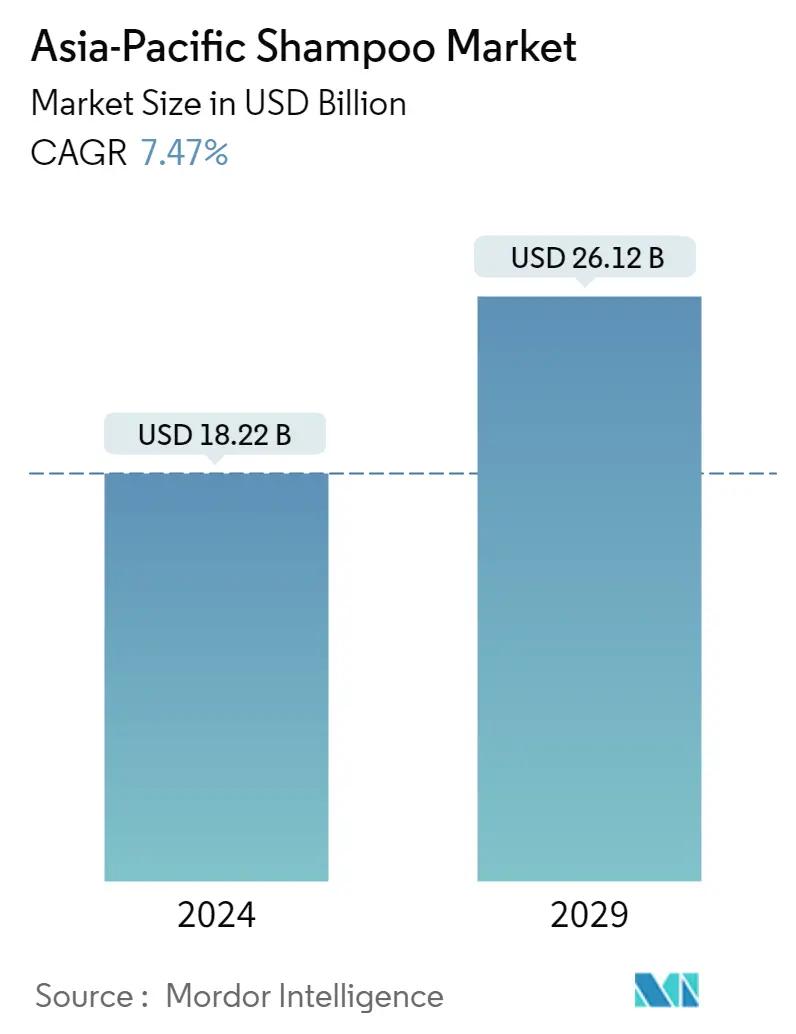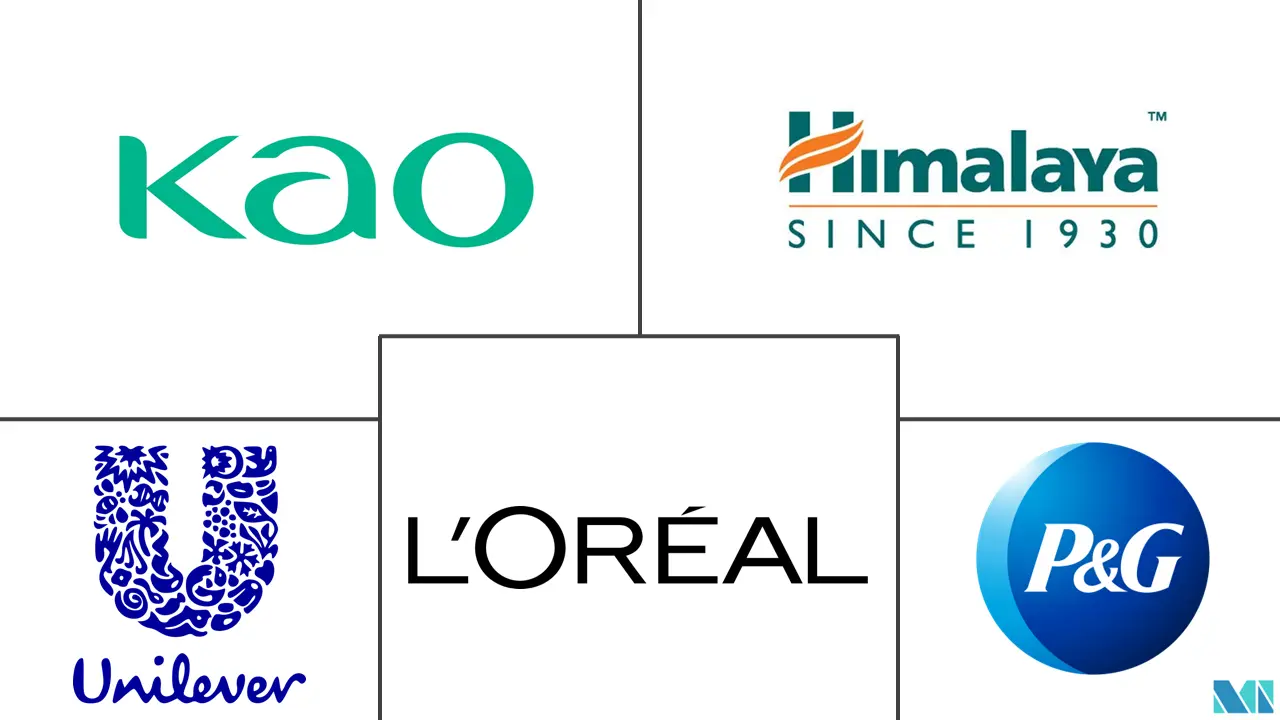Market Size of Asia-Pacific Shampoo Industry

| Study Period | 2019 - 2029 |
| Base Year For Estimation | 2023 |
| Market Size (2024) | USD 18.22 Billion |
| Market Size (2029) | USD 26.12 Billion |
| CAGR (2024 - 2029) | 7.47 % |
| Market Concentration | Low |
Major Players
*Disclaimer: Major Players sorted in no particular order |
Hair Shampoo in APAC Market Analysis
The Asia-Pacific Shampoo Market size is estimated at USD 18.22 billion in 2024, and is expected to reach USD 26.12 billion by 2029, growing at a CAGR of 7.47% during the forecast period (2024-2029).
- Consumers these days are more aware of their hair because of environmental conditions and changing eating habits. Consumer attraction toward foreign hair care products like shampoo is driving the market. Dry hair, dandruff, and grey hair are common hair problems among people. Furthermore, the use of chemical products, constant heat treatments on hair, and excessive usage of hair colors are also contributing to hair damage in the region.
- Furthermore, premature hair aging and hair loss in many countries is the reason that the market for shampoos with quick results is growing in the region. In June 2022, Varese, an Indonesian beauty care brand, launched the Sexpecrum shampoo 2-in-1 conditioner. The product works as a shampoo and conditioner and also treats hair.
- The penetration rate of supermarkets, hypermarkets, and convenience stores provides a platform for shampoo manufacturers to reach customers with a huge range through their innovative product portfolio. The growing adoption of online shopping among customers through e-commerce sites like Amazon, Walmart, Flipkart, and many more are increasing the sale of shampoos through online stores.
- Hence, it expects to gain prominence in the market during the forecast period. Over the medium term, the market is expected to grow owing to consumer awareness, product innovations, and demand for organic products.
Hair Shampoo in APAC Industry Segmentation
Shampoo is a basic hair care product used to clean hair. Different types of shampoos are available in the market according to hair type. The Asia-Pacific Shampoo market is segmented by product type, distribution channel, and geography. Based on product type, the market is segmented into 2-in-1 shampoo, anti-dandruff, kids shampoo, medicated shampoo, and other shampoos. Based on the distribution channel, the market is segmented into supermarkets/hypermarkets, specialty stores, online retail stores, pharmacies/drugstores, and other distribution channels. The market is segmented based on geography into China, Japan, India, Australia, and the Rest of Asia-Pacific. For each segment, the market sizing and forecast have been done based on value (in USD million).
| Product Type | |
| 2-in-1 Shampoos | |
| Anti-Dandruff Sampoos | |
| Kids Shampoos | |
| Medicated Shampoos | |
| Standard Shampoos | |
| Other Shampoos |
| Distribution Channel | |
| Supermarkets/Hypermarkets | |
| Speciality Stores | |
| Online Retail Stores | |
| Pharmacies/Drugstore | |
| Other Distribution Channels |
| Geography | |
| China | |
| Japan | |
| India | |
| Australia | |
| Rest of Asia-Pacific |
Asia-Pacific Shampoo Market Size Summary
The Asia-Pacific shampoo market is experiencing significant growth, driven by increasing consumer awareness and demand for innovative hair care solutions. The market is characterized by a rising preference for foreign hair care products and a growing concern over common hair issues such as dryness, dandruff, and premature aging. The proliferation of supermarkets, hypermarkets, and e-commerce platforms has facilitated greater access to a diverse range of shampoo products, further propelling market expansion. The trend towards organic and herbal shampoos, particularly those incorporating ayurvedic and natural ingredients, is gaining momentum as consumers become more conscious of the adverse effects of chemical-laden products. This shift is particularly evident in countries like India, China, and Japan, where traditional and herbal formulations are increasingly favored.
The competitive landscape of the Asia-Pacific shampoo market is dominated by multinational brands, yet domestic players are making significant strides, especially in the botanical and natural product segments. The market is witnessing a surge in product innovations focused on active ingredients to address prevalent hair concerns such as hair loss and greying. The Indian market, in particular, is poised for rapid growth due to changing consumer dynamics, urban migration, and the rising popularity of vegan and plant-based products. Key industry players are launching products with plant-based ingredients and forming strategic partnerships to enhance their market presence. The introduction of products like Veg Keratin and Wheat Protein range by Beacon Bio Life Sciences and the collaboration between Myntra and L'Oreal Professional Products Division exemplify the ongoing efforts to cater to evolving consumer preferences in the region.
Asia-Pacific Shampoo Market Size - Table of Contents
-
1. MARKET DYNAMICS
-
1.1 Market Drivers
-
1.2 Market Restraints
-
1.3 Porter's Five Forces Analysis
-
1.3.1 Threat of New Entrants
-
1.3.2 Bargaining Power of Buyers/Consumers
-
1.3.3 Bargaining Power of Suppliers
-
1.3.4 Threat of Substitute Products
-
1.3.5 Degree of Competition
-
-
-
2. MARKET SEGMENTATION
-
2.1 Product Type
-
2.1.1 2-in-1 Shampoos
-
2.1.2 Anti-Dandruff Sampoos
-
2.1.3 Kids Shampoos
-
2.1.4 Medicated Shampoos
-
2.1.5 Standard Shampoos
-
2.1.6 Other Shampoos
-
-
2.2 Distribution Channel
-
2.2.1 Supermarkets/Hypermarkets
-
2.2.2 Speciality Stores
-
2.2.3 Online Retail Stores
-
2.2.4 Pharmacies/Drugstore
-
2.2.5 Other Distribution Channels
-
-
2.3 Geography
-
2.3.1 China
-
2.3.2 Japan
-
2.3.3 India
-
2.3.4 Australia
-
2.3.5 Rest of Asia-Pacific
-
-
Asia-Pacific Shampoo Market Size FAQs
How big is the Asia-Pacific Shampoo Market?
The Asia-Pacific Shampoo Market size is expected to reach USD 18.22 billion in 2024 and grow at a CAGR of 7.47% to reach USD 26.12 billion by 2029.
What is the current Asia-Pacific Shampoo Market size?
In 2024, the Asia-Pacific Shampoo Market size is expected to reach USD 18.22 billion.

